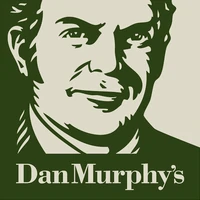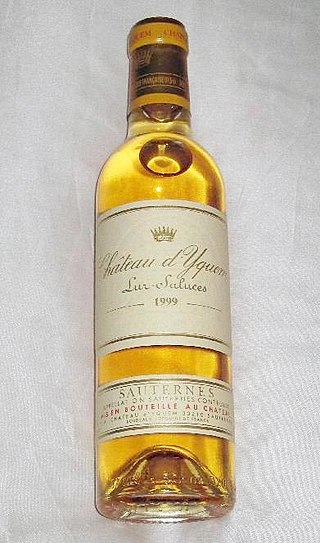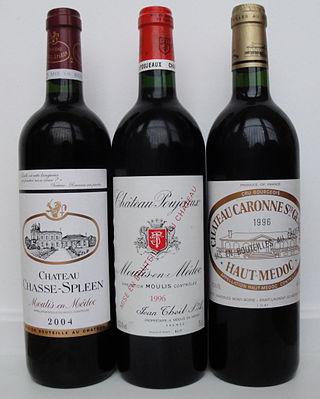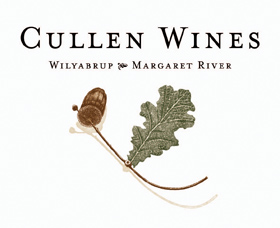Penfolds Grange is an Australian wine, made predominantly from the Shiraz (Syrah) grape and usually a small percentage of Cabernet Sauvignon. It is widely considered one of Australia's "first growth" and its most collectable wine. The term "Hermitage", the name of a French wine appellation, was commonly used in Australia as another synonym for Shiraz or Syrah. Penfolds is owned by Treasury Wine Estates.
Table wine is a wine term with two different meanings: a style of wine and a quality level within wine classification.

Bordeaux wine is produced in the Bordeaux region of southwest France, around the city of Bordeaux, on the Garonne River. To the north of the city the Dordogne River joins the Garonne forming the broad estuary called the Gironde; the Gironde department, with a total vineyard area of 110,800 hectares, is the largest wine growing area in France.

Dan Murphy's is an Australian liquor store owned by Endeavour Group, with over 250 stores across the country. The business was founded in 1952 by winemaker Daniel Francis Murphy. Dan Murphy's competes principally with Coles Group brands First Choice Liquor, Vintage Cellars and Liquorland. The business offers a "lowest liquor price guarantee" and promises to beat any competitor's advertised price.

The Australian wine industry is one of the world's largest exporters of wine, with approximately 800 million out of the 1.2 to 1.3 billion litres produced annually exported to overseas markets. The wine industry is a significant contributor to the Australian economy through production, employment, export, and tourism.

Sauternes is a French sweet wine from the region of the same name in the Graves section in Bordeaux. Sauternes wine is made from Sémillon, sauvignon blanc, and muscadelle grapes that have been affected by Botrytis cinerea, also known as noble rot. This causes the grapes to become partially raisined, resulting in concentrated and distinctively flavored wines. Due to its climate, Sauternes is one of the few wine regions where infection with noble rot is a frequent occurrence. Even so, production is a hit-or-miss proposition, with widely varying harvests from vintage to vintage. Wines from Sauternes, especially the Premier Cru Supérieur estate Château d'Yquem, can be very expensive, largely due to the very high cost of production. Barsac lies within Sauternes and is entitled to use either name. Somewhat similar but less expensive and typically less-distinguished wines are produced in the neighboring regions of Monbazillac, Cérons, Loupiac and Cadillac. In the United States, there is a semi-generic label for sweet white dessert wines known as sauterne without the "s" at the end and uncapitalized.

The Cru Bourgeois classification lists some of the châteaux from the Médoc that were not included in the 1855 Classification of Crus Classés, or Classed Growths. Notionally, Cru Bourgeois is a level below Cru Classé, but still of high quality. Many wine writers consider that there is some overlap in quality between the Classed Growths and the Cru Bourgeois, although also saying that by and large the Classed Growths still represent the best wines.
The classification of wine is based on various criteria including place of origin or appellation, vinification method and style, sweetness and vintage, and the grape variety or varieties used. Practices vary in different countries and regions of origin, and many practices have varied over time. Some classifications enjoy official protection by being part of the wine law in their country of origin, while others have been created by, for example, growers' organizations without such protection.
In considering the Bordeaux Wine Official Classification of 1855, Alexis Lichine held the opinion that the list, some hundred years after the selection was made, no longer expressed the whole truth concerning the ranking of Bordeaux wine. Working for a reevaluation and change of structure of the classification of Bordeaux estates, he ended up spending much of his professional life on a campaign that lasted more than thirty years to accomplish a revision. Having published his Classification des Grands Crus Rouges de Bordeaux in 1962, with several revisions over the following years, Lichine came to be viewed as "the doyen of unofficial classification compilers".
The Liv-ex Bordeaux Classification was created in 2009 by the London International Vintners Exchange, the global marketplace for the wine trade. The classification of 2009 was inspired by the historical Bordeaux Classification and ranked the wines of the Bordeaux Left Bank solely on the price that each wine was worth at the time. Since then, the classification has expanded to reflect the changing conditions of the market for fine wine, and has been updated in 2011, 2013, 2015 and 2017. The latter extended beyond Bordeaux to include wines from the rest of the world for the first time.

Howard Park Wines are Margaret River and Great Southern wine specialists and a family-owned winery owned by the Burch family, which is responsible for such brands as Howard Park, MadFish, and Marchand & Burch. With an established winery based in Margaret River, Western Australia and vineyards in the Great Southern, the Burch family are the first Australians to gain ownership in the production of a French Burgundian Grand Cru.

Henschke is a family-owned, 155-year-old Australian winery, located in Keyneton, South Australia in the Eden Valley wine region. It produces the 'Hill of Grace', one of Australia's "cult wines", and was considered Australia's second best wine by James Halliday in 2009.
Clonakilla is an Australian winery based in the Canberra wine region of Murrumbateman, New South Wales.
Giaconda is an Australian winery in Beechworth, Victoria.
Grosset Wines is an Australian winery based in the Clare Valley wine region of South Australia.
Leeuwin Estate is an Australian winery and restaurant based in the Margaret River wine region of Western Australia.

Cullen Wines is an Australian winery based in Wilyabrup, within the Margaret River wine region of Western Australia.
Bass Phillip is an Australian winery based in Leongatha, within the Gippsland region of Victoria.

Charles Melton Wines is an Australian winery based in Tanunda, within the Barossa Valley wine region of South Australia.
Dalwhinnie Wines was established in 1976 by Ewan Jones. The vineyard is located in the cool climate of Moonambel. Moonambel is a sub-region of Victoria's Pyrenees wine region, which was pioneered by the vineyards of Taltarni, Warrenmang, Redbank and Dalwhinnie.









